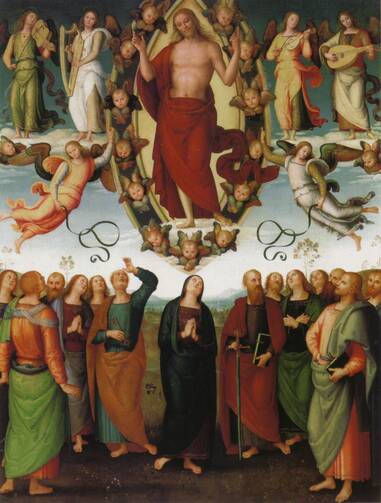As he saw it, he didn’t just make it. He was history. “I am the revolution.” That was the explanation Napoleon Bonaparte offered in 1804, when he announced that he would be crowned Emperor of the young French republic. As Bonaparte saw it, stability would never come to France as long as royalist or Jacobin plotters sought a change of regime through his assassination. Founding a dynasty would bring security, he explained. “They seek to destroy the Revolution by attacking my person. I will defend it, for I am the revolution.”
In his sweeping Napoleon: A Life(2014), Robert Andrews concurs with the emperor.
Napoleon had a point. In 1804, he was the revolution. History, the hope of France, depended on him.
The relationship between history and single person is also a fruitful way to access the Ascension of Christ, to understand its implications. Ascending to the right hand of the Father, his human nature entering the Godhead, Christ doesn’t depart from history. Far from it. He commends his mission, which is his very self, into history.
Saint Mark’s Gospel is very clear on this point. Before “leaving,” Christ commissions the apostolic band.
and proclaim the gospel to every creature.
Whoever believes and is baptized will be saved;
whoever does not believe will be condemned (16: 15-16).
The project of Christ is his person. He is himself the Kingdom of God among us. Jesus enters history as one who is sent by the Father. In him, mission and identity are one, because he gives himself entirely to his vocation, his calling from the Father.
Person comes from story. We become ourselves in the lives that we live. Entering history, Christ forges a unique human nature within it. He is the one who was born in Bethlehem, who preached the kingdom in Galilee, who suffered and died in Jerusalem, and who was raised from the dead into glory. Whatever changes he brings, however he alters history, he does do through his very person, not a program.
Now, at the end of Gospel, Christ’s human nature, forged on earth, is raised to heaven. Jesus is seated at the right hand of the Father. The resurrection and ascension are not Jesus departing from history. They are Christ claiming time, drawing all of it into his person.
His is not an agenda needing to be assigned, a task left for the Church to perform. The Church is the presence of Christ, his person still active in history. Clearly, that isn’t the way many of our contemporaries see it. This week, The New York Times reported that
For many, the Christ is no longer savior. He is only a symbol of humanity’s spiritual aspirations. Once you’ve got the idea, you’re free to make of him what you will.
Yet the resurrection, the ascension, and the bestowal of the Spirit to the Church are inextricably linked.
and you will be my witnesses in Jerusalem,
throughout Judea and Samaria,
and to the ends of the earth (Acts 1: 8).
In the three, the humanity of Christ is exalted and, at the same time, it undergoes its final and deepest emptying, into the communion of saints, which we call the Church.
The Christ suffers himself to be the Church, to be its head, to be active in its history, despite its sinfulness, its prejudices, its all-too-human shortcomings. This does not mean that everything the Church’s members do becomes his own. Even the Church carefully circumscribes her actions in the name of Christ. It does mean that Christ never ceases to call men and women into the community we call the Church.
and gave him as head over all things to the church,
which is his body,
the fullness of the one who fills all things in every way (Eph 1: 18-23)
Napoleon insisted that he was the revolution, and, for a time, he was right. Christ claims to be history. If that’s true, he claims us, and he does so through the agency of the Church. One can work for an idea, pursue an ideal as one likes. But if Christ offers us his very person in the Church, we can only respond as persons. Communion is only possible in community. Outside the Church, Christ is a cipher. In it, he is waiting to be loved.
Acts 1: 1-11 Ephesians 1: 17-23 Mark 16: 15-20








